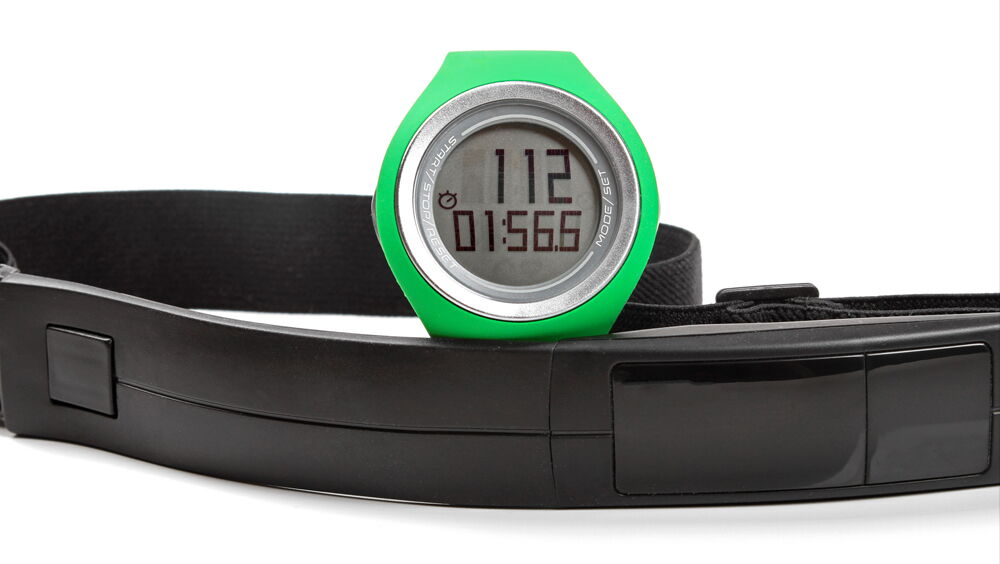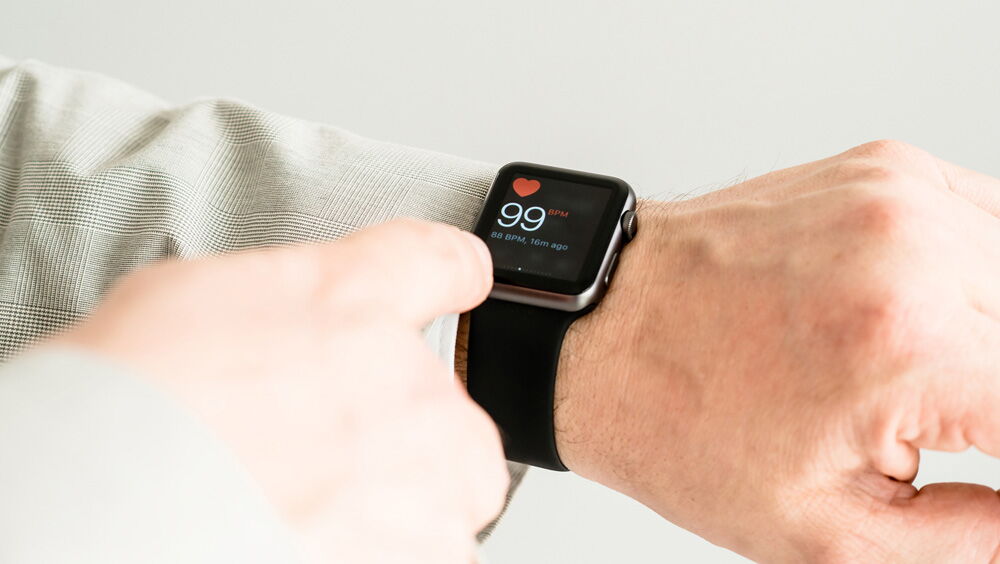The use of a heart rate monitor allows you to develop a customised scientific program, as it provides continuous information about the heart rate and therefore about related physiological activities.
Training with a heart rate monitor
The motivation that drives many people to run 2 or 3 times a week is to obtain and maintain a good cardiovascular condition; running regularly generates benefits to the heart, lungs and the entire cardiovascular system: the heart increases in size, so it beats more slowly and the pulsations are more powerful and effective.
When exercising, the heart of a trained athlete increases the pulse more moderately, and can maintain this pace for a longer time without tiring, and after the stress is removed, returns to the resting frequency faster. In practice, it does more work with less fatigue.

To achieve these beneficial effects, during the stroke, you need to keep the heart rate within a very precise range, depending on your age and fitness condition; in most cases this ranges from 120 to 140 beats per minute (bpm) .
To ensure you're training within this range, you must therefore keep your heart rate monitored, which can only be done easily and precisely with the aid of a heart rate monitor, as manual measurement during training are practically impossible, while at the end of training, it is unreliable because it has already started to recover.
Measuring with the heart rate monitor instead provides real-time reliable information/measurements, highlighting any unplanned variations, and various abnormalities that could alter the effectiveness of training.
The use of the heart rate monitor is very important in the two extreme cases, like post-infarct cardiovascular rehabilitation and agonistic training.
More generally, however, it is useful to anyone who is passionate about training is mainly aiming at three types of objective:
- achieving good physical shape and retaining physical health
- keeping their heart function in good health
- achieving a good physiological yield to supply a good performance
Workout objectives
The reasons for most people who practice training workouts are as follows:
- being fit and highlighting this condition
- keeping your heart healthy
- improving performance
The above objectives are achieved with 3 different training intensities; but how to know if the type of training you're undertaking is the right one? Your own right "target zone" is this: this is a precision training achieved by maintaining the heart rate (f.c.) within a maximum heart rate (f.c. max.) percentage band.
For the three objectives above, the "target zones" are respectively:
60-70% of maximum heart rate
70-80% of maximum heart rate
80-100% of the maximum heart rate
Let's look at each of these three objectives in detail
Training to lose weight and keep fit
If the objective is to look good, you'll need to workout with a heart rate of between 60 and 70% of the maximum cardiac frequency.
This is the most effective level for reducing body fat, and there is also a slight increase in muscle tone; there are also the first improvements in cardiovascular conditioning and an increase in "resistance", that is, the ability to run for long distances, even for many hours, a quality that cross-country and competitive runners should have.
Training for cardiovascular conditioning
If, in addition to looking in good shape, the objective is also to get healthy and achieve a highly efficient heart and cardiovascular system, you'll need to train more intensely. The workout "target zones" must be between 70 and 80% of the maximum heart rate. This type of exercise is ideal for improving the peripheral circulation, i.e. creating new blood vessels to serve the heart and muscles. This training intensity is sufficient to be able to take part in road races, or just for fun and without any particular agonistic objectives.
Training as a competition
Anyone who aims to compete at the maximum level of his/her ability will have to train by keeping the f.c. between 80 and 100% of the maximum f.c. Of course this training intensity must be achieved gradually, to give the body time to adapt physiologically to this intense workload and to avoid damage to health.

Training yourself with this method leads to the achievement of maximum levels of speed and resistance whilst at the same time, optimising energy expenditure during activity, which will be much lower when compared to that of an untrained person.
Identifying personal "target zones"
To use the heart rate monitor effectively, you need to establish personal "target zones", which depends on both your age and personal cardiovascular efficiency. A concrete example is the following: Two people of the same age who decide to train for the same objective, set a weight loss and then work in the "target zones" 60-70% max. f.c. are likely to have to train at different heart rates, because one of them may have a higher cardiovascular efficiency or a lower heart rate than the other. So one of them will train at between 120 and 140 bpm, and the other between 111 and 130 bpm.
To simplify identification of the "target zones" we have suggested a table that, by taking the heart rate and maximum heart rate into account, is particularly reliable in providing this data.

The fc values ??at rest and maximum are measured as follows:
RESTING HEART RATE - wear the heart rate monitor in the morning when you've just woken up and, while lying on the bed, measure a value for your heart rate. To obtain a reliable result, it's best to take a measurement for 5 consecutive days and then use the average of the 5 values.
NOTE: The resting, or baseline heart rate, is a good indicator of physical fitness. The fitter you are, the lower your resting heart rate, because the heart, after physiological adaptation due to exercise, increases in size and achieves more powerful and vigorous beats; this means it takes less effort to circulate blood through the cardiovascular system, and therefore has to do less beating.
F.C. MAXIMUM - The maximum heart rate can be determined in 2 ways: 1) Measure it directly. 2) Deduce it from a calculation.
- DIRECT MEASUREMENT OF F.C.MAX: a precise measurement of the maximum f.c. can only be carried out with the aid of a mobile carpet or a cycloergometer; it is also possible to measure it "in the field," but is more difficult.
- F.C. MAX. OBTAINED BY CALCULATION: in many places, you'll find the well-known formula of '220 -AGE'. The results from this method are, however, very approximate and often quite inaccurate. That's why we'll use a table with a graduated scale table that gives much more accurate results. This table was worked out as a result of research and experiments performed on thousands of athletes by eminent academics.
The advantage of using this table, as compared to the formula 220 - AGE is that by starting from subjective actual data (fc at rest and maximum) you can adapt the training by updating the "target zones" according to the progress you've made in terms of physical fitness (it's well-known that physical fitness lowers the f.c. measured at rest).
If for some reason, it isn't possible to obtain maximum fc data measured by stress tests, you can use the table starting from a single actual data point, the fc at rest, and deduce the fc max according to age as reported in the table itself .
General information about targeted training
The training criteria are:
- intensity
- duration
- frequency
- type
Intensity in turn can be: light (60-75% of fc max.), Medium (75-85% of fc max.) And heavy (85-95% of fc max.).
Distance (duration) and speed (intensity) can be combined in various ways according to whether you want to perform light, medium or heavy training workouts.
However, it is very important to keep up with the rule of alternating light training days with heavy training days to ensure your body has enough recovery time and to prevent the damage caused by over-training.
The right combination of these elements will form your customised training program.
Training to keep fit and control weight
With this type of workout, you can reduce and control your body weight, achieve a good level of physical fitness and look fit:
Depending on individual starting characteristics, the level you want to achieve, the time available and other personal variables, workouts can be divided between 3-4 days a week, depending on the level of engagement you choose to operate at. To set these different levels of training engagement, the four training methods that we describe below should be applied and combined:
To set these different levels of training engagement, the four training methods that we describe below should be applied and combined:
Long and short training
This method involves training 3 times a week, such as on Mondays, Wednesdays and Fridays, running slowly, keeping the heart rate at between 60 and 70% of your fc max.
The duration should be 20 minutes for beginners or 30 minutes for people who've been running for some time.
After training, it is important to perform exercises to stretch the muscles of the thighs and calves to keep them elastic.
Slow running of medium duration
This type of training workout should be performed on Tuesdays and Thursdays; it's a bit more challenging than the previous one, even though the pace is equally slow (60-70% of your fc max.); the duration is in fact longer: 30 minutes, progressing to 45 minutes and it starts to be useful for reducing body fat. After the workout, always perform the stretching.
Fartlek
This training method is performed once a week, on Saturdays. It consists of alternating running at a medium-fast run, at a limit of 75% fc max. and at a slower pace, at 60% fc max., i.e. training at the maximum and minimum limit of the "target zone" of 60-75% by moving quickly from the maximum limit to the minimum limit, and then re-accelerating and returning to the maximum limit as follows.
You start running 1,500 metres at 60%; then do a FARTLEK of 1,500-3,000 metres, running alternately at 60% and 75% of your fc max.
With FARTLEK, you gain the strength and muscular flexibility in the legs that are essential qualities a runner must posess. Don't forget to stretch at the end of the workout.
There is no rigid scheme for exercising FARTLEK, but it can be customised according to your preferences: you can get up to 75% gradually or, by running fast, in the shortest time possible. Even returning to 60% can be faster or slower, depending on whether you want to run (slowly) or walk.
Short and long running
With this training workout, to be done on Sundays, run for 45-60 minutes with an fc between 60 and 70% of the fc max. After the workout, do the usual stretching.
